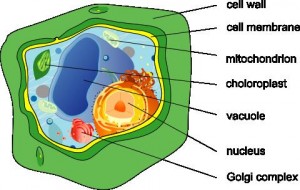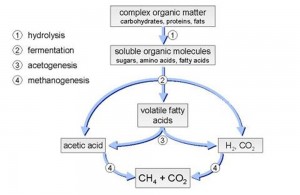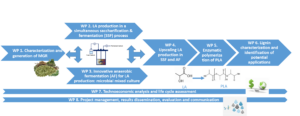![]()
Biogas from microalgae
Autor: Ahmed Mahdy-Instituto IMDEA Energía
Among all benefits that microalgae exhibit, biofuels production is a promising option to reduce our dependence on fossil fuels. Microalgae can provide different types of renewable biofuels such as biodiesel, biohydrogen, bioethanol and biomethane via chemical or biological reactions. Nevertheless, one of the barriers to develop microalgae sustainable energy production is the breakdown of the rigid cell wall that prevents an efficient conversion (Fig.1, [1]). Therefore, cell wall disruption is considered a major hurdle to reach a feasible biofuel conversion from microalgae.

Figure1. The composition of algal cell
Opposite to biohydrogen, bioethanol or biodiesel that only uses determined macromolecules (carbohydrates and lipids), biogas is produced by biological means under anaerobic conditions that converts all microalgae macromolecules into methane (Fig. 2, [2])
Figure 2. Pathways for mineralization of organic matter to biogas in an anaerobic digestion process
Two approaches can be followed to enhance methane production of microalgae, namely pretreatment of microalgae to render organic matter more bioavailable and co-digestion with other substrates to increase the carbon/nitrogen ratio [3]. Regarding pretreatment, enzymatic pretreatment of microalgae seems to be a promising approach with comparison to chemical or physical methods. More specifically, with enzymatic pretreatment, we can decrease energetic input during pretreatment since the pretreatment is conducted at mild temperature; there are no inhibiting by-products and enzymes are pretty selective for specific chemical linkage [4]. The main hurdle of using enzymes is the high cost of these biocatalysts, however we can overcome this problem by producing enzymes in situ since there are many bacteria and fungi that can produce the required enzymes. Another potential strategy would be anaerobic sludge bioaugmentation. This strategy involves sludge enrichment with the identified microorganisms able to release the most suitable enzyme for microalgae cell wall disruption. The work in Biotechnological Processes for Energy Production Unit – IMDEA Energy aims at increasing energy conversion efficiency using microalgae feedstock for anaerobic digestion.
References
[1] http://imgarcade.com/1/algae-cell/
[3] C. González-Fernández, B. Sialve, N. Bernet, J.-P. Steyer, Biofuels Bioprod. Bioref.6 (2012) 205–218.
[4] A. Mahdy, L.Mendez, M. Ballesteros, C. Gonzalez-Fernandez, 2014. Energ. Convers. Manage.DOI: 10.1016/j.enconman.2014.04.097


